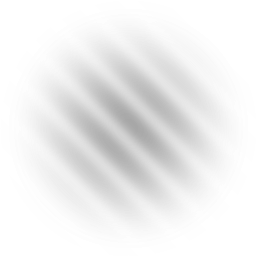This experiment is called Online Cueing.
In this experiment, you will perform a simple attention task. After a brief calibration task, you will need to do 8 blocks of the experimental task. Each block should take about 2.5 minutes. It should take less than 30 minutes total. Please read the instructions below closely! Thank you for taking the time to help me with my research.
The Task
In this task, you will be looking for a target that will be presented on either the right or left side of the screen. This target will be a visual grating turned either clockwise or counterclockwise from its upright position. Here is an example of a target turned counterclockwise (on the left) and clockwise (on the right):



The target can appear in one of two possible locations on either side of the screen indicated by circles. There is also a small circle in the center of the screen where you should keep your eyes. Here is what the display looks like:

Your job is very simple: to report the direction that the target was turned at the end of each trial . You will make this report with the "m" and "n" keys, pressing the "m" key if the target is turned clockwise (i.e. to the right) and the "n" key if the target is turned counterclockwise (i.e. to the left). Note: You are not reporting the location of the target, but instead it's direction of rotation.
In order to make this task challenging, there will be a distracting event: The target will be followed by a visual noise mask. This noise mask will be presented in the same location as the target. You will simply ignore this event and look for the target (turned grating), which is the only relevant stimulus that you'll see. The target will be presented very quickly, so you'll want to pay close attention! Here are a couple trial examples, with the first one slowed down and second one full speed:
As you can see, this presentation happens very quickly, which means that you will not have time to move your eyes to the target locations. Therefore, the best strategy to ensure that you maximize your task accuracy is to keep your eyes on the tiny circle in the center of the screen.
You will now perform a short calibration portion of the experiment. When you finish this part of the experiment, you will be automatically re-directed to the main part of the experiment. Thank you for participating!
UNIVERSITY OF CALIFORNIA, SAN DIEGO
CONSENT TO ACT AS A RESEARCH SUBJECT
Viola Störmer, Ph.D., is conducting a research study to find out more about attention, memory and vision. You have been asked to participate because you are a healthy young adult. There will be approximately 1500 participants in this study this year. The expected duration of the study is 10 years, though your participation will last only between 3 minutes and 90 minutes, with the exact expected timing listed in the task description.
PROCEDURES. If you agree to participate in this study by accepting this agreement and continuing in the task, the following will happen to you:
1. You will be shown displays of letters, words, or pictures, right here in your web browser.
2. You will try to perceive and remember these stimuli, and respond by pressing keys or moving and clicking the mouse in a manner that we will describe to you.
RISKS. You will be required only to continue to interact with your web browser and make responses for a short duration. Thus, no potential risks or discomforts are anticipated except for the possibility that some tasks may be slightly boring. However, there may be risks that are currently unforeseeable.
PAYMENT/REMUNERATION. In consideration of your time, you will receive payment at the rate described through the recruitment system, in either course credit or monetary renumeration. Compensation will range from $0.60 (for a 3 min task) up to as much as $20 (for a task that takes 90 min), with rates between $8/hr and $12/hr. The exact payment rate for this task is provided in the task description.
RIGHTS. You may call the UCSD Human Research Protection Program at 858-246-HRPP to ask about your rights as a research subject or to report research-related problems.
BENEFITS. There will be no direct benefit to you from these procedures. However, the investigator may learn more about basic questions pertaining to attention, memory and vision. This knowledge may have benefits to society in fields ranging from improving education to visual design, but these benefits will be indirect.
EXPLANATION. The researcher has explained this study to you and answered your questions. If you have questions about the research or research-related problems, including any adverse events, you may reach Dr. Viola Stoermer at vstoermer@ucsd.edu or 858-822-4530.
VOLUNTARY NATURE OF PARTICIPATION. Participation in research is entirely voluntary. You may refuse to participate or withdraw at any time without penalty. The alternative to participation is to choose not to participate.
CONFIDENTIALITY. Research records will be kept confidential to the extent allowed by law. As with all research, there is also the possibility of loss of confidentiality. Information from participants such as yourself will be identified by a subject number, which is not associated with your identity, by the researchers, to minimize the potential loss of confidentiality.
By clicking the button below, you are indicating that you are at least 18 years old, have read this consent form and agree to participate in this research study. Please print a copy of this page for your records.
